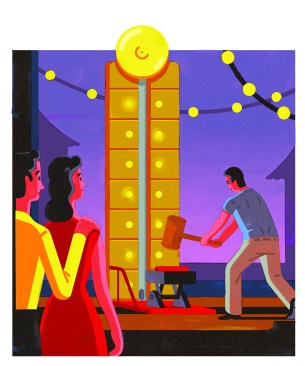Thirty years ago, Bruce Springsteen kicked off his Tunnel of Love album with sounds from a carnival midway followed by an hour’s worth of songs about love gone wrong. One reviewer said the album “zeroes in on fear of commitment as a pathology and battles it.” Another declared: “You really shouldn’t be allowed to hear this record until you’ve been married for a few years, though at that point it might strike a little too close to home.”
Attraction, fear, commitment, disillusionment: These emotions are a lot like what homeowners go through in a remodeling project. Knowing that, it’s no wonder why many firms warn prospects of what’s to come by sharing a cartoon showing the customers riding an emotional roller coaster that starts with the initial design and rolls on through the final punchlist. Hold tight to the handrail, remodelers warn, and trust us that this thrill ride will come to a satisfactory end.
Remodeling’s emotional wallop is no less powerful than it was when Springsteen recorded his album, but the audience has evolved. Marketing experts and survey findings agree that Americans are less trusting than they were decades ago, more likely to be skeptical at first, and more able and likely to broadcast their opinions about how well you did. And among younger generations, there’s a greater likelihood that they will want to reach out to you electronically rather than face-to-face.
Keep It Personal
But here’s the ironic catch: For all the talk about making digital connections and hiring handymen through social media, there’s wide agreement that homeowners hunger more than ever for a personal connection when they hire a remodeler for anything but the smallest job. Prospects want to feel they can trust and have a great relationship with the person who’s coming into their house and disturbing their lives. And remodelers say they want the same.
“One thing I’ve noticed in talking to business audiences, to all kinds of people, is that people want—they crave—this human connection,” says Crystal Washington, a social media consultant. “And so when you have business owners that come out and shake your hand, or that send you hand-written notes after they’ve met you … those little touches make a really, really big difference across generations. “
That’s why one event, more than any other, is crucial to the sales process: the face-to-face meeting. It’s still a nerve-wracking trip into the Tunnel of Love, but with some modern twists that can help assure you don’t emerge full of regrets.

Peter Ryan
Play Jazz
The old way remodelers were taught to act at a sales meeting was similar to how an orchestra performs classical music: You play the same notes every time, varying mostly in tempo or intensity.
“In 2003, every company had their own sales process,” says Mike Lane, who trains thousands of reps each year for Basement Systems, a Seymour, Conn.-based home improvement company. “You think, ‘This is the process, go out and execute it, and you’ll be successful. Here’s how we make our confirmation call, how to introduce ourselves, set the agenda, the questions we ask, how to do the inspection, how to ask for the order, and how you follow up.’ And for a long time that was great.
“As we move into 2017, the mindset has shifted to the experience that we’re going to give the customer,” says Lane, who used to be a musical orchestrator for pop singer Michael Bolton and who got his sales start working in a guitar store. “What type of experience are you going to give them? What do you think they should be saying at this part of the sales visit? What should they be feeling and thinking and saying at this part of the visit?”
In a sense, what Lane wants is for salespeople to be more sensitive and allow themselves to connect better with their customers, the customer’s problem, and why the customer feels they want their remodeling project done.
Mike Klein, CEO of The Airoom Companies, a $30 million design/build firm based in Illinois, makes sure his staff keeps their ears attuned to every note so they can respond in kind. From the first meeting, “we want to find out what they’re thinking about,” he says, just as “we want to clarify the type of work that we do, that our company is interested in doing.”
Airoom Companies staff ask early on whether the prospect has plans or ideas put together already, he says, and in response, “we want to give them general parameters for the type of work and pricing, based upon what we’re hearing … to try to eliminate the absurd in the beginning.”
If the relationship swings, Klein’s team will set up an appointment. But it’s just as likely Airoom will conclude the relationship isn’t going to work and thus break things off right there. “We tell them that it’s probably not the right scope of work or the right type of project for our company,” Klein says, “but we appreciate the opportunity and we just are upfront and honest about it. We don’t make it into a long saga.”
Consistently Varied
While trainers like Lane want sales reps to vary their approach based on the prospect’s response, don’t think they are endorsing a totally free-flowing conversation. Rather, they want you to range as far afield as is needed to get the prospect back to your objective: signing the contract at the price you set. And you needn’t rely on talk alone to get there.
Rodney Webb likes to get inside a customer’s head, but not just any part of the head; he aims to reach your brain’s limbic system, where most of your emotional life occurs and memories are stored. Find a way to talk to the prospect’s limbic system, the sales consultant says, and “it puts price way down the totem pole.”
Webb (no relation to the author) believes one of the best ways to trigger an emotional response from the customer during a sales meeting is to show them videos of what’s wrong with their home and how you can fix it. Says Webb, “If they feel you’re the ultimate expert, they’ll do what you say 70% of the time.”
He particularly recommends using a device you can wear on your head, like a GoPro camera, to do the recording as you provide commentary that shows you know what you’re doing. Making the recording will require you visit the jobsite in advance of your customer sit-down, but that visit is an investment that should pay back in higher close rates.
Here are some of Webb’s keys to creating these videos:
• Lead with the basics. As you start taping, give the date, location, and the customer’s name. Begin recording a reasonable distance from the house and walk toward it as you reel off the opening information. That sets the scene and makes everything that follows sound more authoritative.
• Wear gloves and use a pointer. Aside from making you appear more professional, the pointer will focus attention, and gloves will enable you to show smudges when that helps make your case.
• Show your expertise. Use industry terms for problems you spot and cite industry knowledge. For instance, “This type of shingle has a 10-year warranty. With our weather conditions, they usually don’t hold up longer than that.”
• Keep safety in mind. Worried about heights? You needn’t climb up onto the roof or go completely into the attic if, just by standing at the top of the ladder, you can show enough problems to justify the need for repairs. You don’t even need to shine a light in the attic at first if holes in the ceiling become apparent when the rest of the attic is pitch-dark.
• Look at the big picture. If you sell multiple products, such as insulation as well as roof repair, and were asked to quote a roof job, don’t hesitate to point out other problems you see that you could solve. “All you’re doing is saying, ‘This is what I see. This is how to fix it,’” Webb says. “You’ve earned the right to upsell.”
• Use the proper tools. Employ devices like a thermometer to show how hot it is on the roof or in the attic.
• Keep it short. Between 90 seconds and two minutes. “The video isn’t designed to show everything that’s wrong,” Webb says. “It’s just presenting evidence that the problem you’re citing is the truth.”
Webb’s background is in home improvement, and his goal is to get a contract signed on his first and only visit. (He claims a close rate of as high as 91%.) Klein differs here: He regards the first in-home meeting, and the necessary preparation for it, as steps in his continual quest to determine whether the prospect is a good match.
“We look for our jobs in the area that we’ve worked in,” he says. “We try to do some initial zoning analysis as well on the properties before we get there. We try to do a little bit of research on the client that we’re going to see so at least we know a little bit of background about that person.”
At the meeting itself, Klein says, “that’s the point where you really decide whether or not you go to the next step, which is to do a lot more work and come out and start flushing out ideas and details, design specifications, and go down that path. Or, you know, it’s not the right time, or it’s not the right fit, or they were totally shocked by the sticker ranges and just thought it was going to be something so much less.”

Peter Ryan
Tools to Get to Yes
So, you’re at the meeting and it’s time to talk about the contract and discuss price. What then? Wait a minute, Webb advises. After you show the inspection video but before you bring up money, it’s time to do two other things: bring up references and show another video detailing what’s involved in the job.
Webb urges his clients to create a contact sheet listing up to a half-dozen former customers who will give personal endorsements to your potential buyers. Webb calls them “character witnesses” who should be called on before you present a price and ask for the sale.
But these aren’t crudely produced handouts. Each part has been carefully thought out:
• Give only one sheet to the customer.
• Limit references to six at most.
• Put at the top of the list somebody whose job you messed up but then made things right. That will prove to the prospect that you give great service even after you’ve erred.
• Include each reference’s name, address, and phone number.
• Include a picture for each reference. Ideally, you (the sales rep) should be in it.
• At the bottom of the page, include three sample questions that your prospect can ask the reference. For instance: “Did the company do everything they told you they would?” “Did they clean up?” And: “If you had to do it over again, would you use the same company?”
• To avoid wearing out potential references, get enough candidates to fill four sheets. Then rotate which sheet you give the prospect.
• Ask the customer to make the call while you’re somewhere else in the house taking measurements. This will give the customer something to do while they wait. And with a good reference, it increases the odds they’ll think favorably of you when you return.
• If they balk at calling, give them some motivation. For instance: “For each person you talk to, I’ll take $100 off the job.”
• Don’t pay customers to be on the list. They should only be on it because they want to be.
People like to give references, because they feel good when they help others. People who get one or two calls every couple of weeks will stay on your list forever, says Webb. ‘They’ll pitch with passion.”
After that, he says, show a video your company has created explaining the entire remodeling process, from the arrival of the first truck to the final cleanup. Showing the entire process not only helps the customer understand everything they’re going to get and in what order, it also helps show why you’re better by letting you point out services that competitors might not provide.
Put Cost vs. Value To Use
Now you’ve set the scene: You understand what the customers need and have concluded that—even after they’ve seen the drawing of the roller coaster—these prospects are people you’d enjoy working for. You have a proposal in your pocket. But before you pull out that contract and show them the price, pull out something else first: Remodeling’s Cost vs. Value report.
Pros across the country attest to how Cost vs. Value helps homeowners realize that a professional remodeling job typically costs more than they imagined. And in this era of cable TV shows, where jaw-dropping results are achieved for a pittance in less than 60 minutes, Cost vs. Value’s worth has grown, pros say.
Unlike services that claim to report average or typical costs for remodel jobs that were performed, Cost vs. Value bases its numbers on what it would cost to do any of 29 theoretical projects in each of 99 markets nationwide. We put the same amenities into the same-sized space, varying their price by market. Likewise, while we assume it takes the same amount of labor to do the work, we vary labor costs according to the local rate.
After that, we add the same corporate expenses: taxes, worker’s comp insurance, and general overhead items like the cost of having an office, a website, a phone number, utilities, company vehicles, and equipment. Finally, we add a reasonable profit.

Thanks to this consistency, Cost vs. Value can reveal how dramatically prices for the same work can vary across the United States. The same roof replacement costs $17,987 in Little Rock, Ark., but $26,991 in Boston. A backyard patio that’s priced at $46,348 in Titusville, Fla., will set you back $63,891 in the Chicago metro area.
If the prospects think the cost of job you’ll perform will more than pay itself back when they sell the home, well, Cost vs. Value can set the record there, too. That’s because after determining the costs of doing those 29 projects in 99 markets, we then survey real estate professionals from coast to coast, asking them to estimate how much higher the home’s price could go if it were put on sale within a year of when the work is done.
The truth you should stress is that a job that’s done by a pro rarely will pay back at resale a higher amount than was invested in it. In our 2017 report, only one of the 29 projects returned more than 100%. That job involved blowing fiberglass insulation into an attic. It paid back $1.08 for each dollar invested. In contrast, the worst return was for a midrange bathroom addition; it paid back 53.9 cents on the dollar. The average for all 29 was 64.2 cents. In general, work to replace items that are broken or need simple changes, like replacing a steel entry door or a vinyl window, score higher paybacks than more discretionary projects, such as constructing a two-store addition or updating a kitchen.
If the customers ask why the paybacks fall so far below what others say, remind them that we’re not talking here about repainting some rooms or planting flowers; most Cost vs. Value projects range from difficult to impossible, not to mention dangerous, for a DIYer to do.
And if the prospect doesn’t plan to sell within several years of the project, tell them to ignore payback numbers. They are closely tied to the latest rises and falls in home prices, and we all know how quickly those can change within a few years.
Financial Alternatives
Even after all that, customers still might be surprised by your price or find themselves unable to do all they want. For those customers, it’s time to suggest financing.
John Harris, executive vice president of sales and marketing at Enerbank, says that client companies that offer his firm’s payment options to all customers and advertise it in all cases see a 25% increase in leads and close rates and a 30% increase in average project size.
But note the reference to advertising, because Harris says he’s found that if you don’t suggest financing early on and instead wait until the customer objects to the price, “that’s kind of too late, because the client has the opportunity to build up a head of steam and essentially jump immediately into discounting and other solutions to get what they want.”
Lane, whose Basement Systems employer uses Enerbank, says he believes in financing.
“It’s a big part of our business,” he says. “These days, customers like to use financing whether it’s a ‘same as cash’ plan or monthly payments. It makes it easy for customers and salespeople. The key is to become expert at presenting it so it’s not too complicated.
“Recently, I was on a sales visit observing a salesperson,” Lane recalls. “He was done and didn’t succeed. I repositioned the financing [and] connected with the customer on an emotional level where she realized the financing made it painless for her to enjoy her new remodeling project.” That closed the deal.
Like Lane, Klein says one key to better sales is training, and the key to training is knowing how to deal with emotions. “There’s certainly a point where you could spend too much time and miss that contract, which you see plenty of people do,” he says. “There’s also a point where you could spend too little time and not get the contract on the basis of that. That’s sales training. That’s not design training. It’s not about architecture and it’s not about specifications. That’s about selling and understanding a sales funnel and the emotions of people.”
